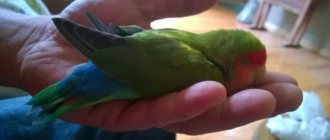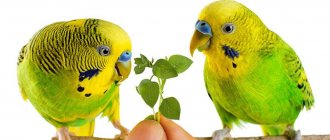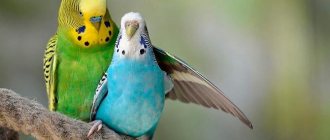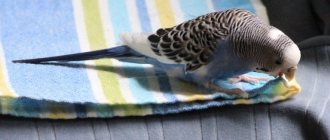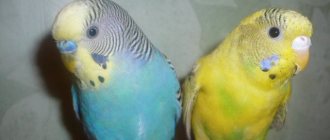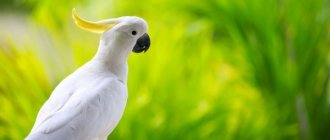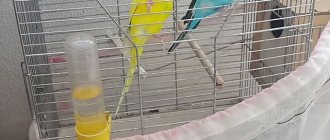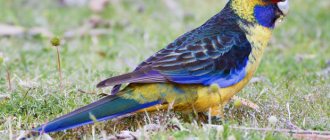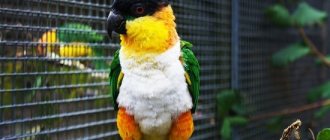When choosing a parrot, a person does not always think about how long a feathered pet can live in captivity. Small birds can bring a lot of positivity to a family, create comfort and a favorable atmosphere of friendly communication. Do not forget that tiny budgies are very fragile creatures; they need to be surrounded with care and special attention.
Lifespan of budgerigars in the wild
In its homeland, this bird does not live long, no more than 4 years. In rare cases, up to six. This is influenced by the laws common to the wild environment - natural selection and the struggle for survival.
Lifespan of a budgie
The cycle of growing up, according to the rules of nature, in the wild is as follows:
- development of the embryo in the egg and hatching (the mortality rate here is colossal);
- the first days, weeks and months of the chick (a very risky time);
- youth (the most active and safe period);
- fading of strength, decline of immunity, exhaustion and inevitable death (as a result of an accident, due to climate change or from the clutches of a predator).
Read also
Is it possible to give parrots a boiled egg?
Origin of the species and description
Photo: Budgerigar
The genus name Melopsittacus is translated from ancient Greek as “melodic parrot.” It is the only species in the genus Melopsittacus. The birds coexisted with Indigenous Australians for 70,000 years. The species was first described by George Shaw in 1805, and the current binomial name was assigned to the bird by John Gould in 1840. An outstanding ornithologist compiled a more complete review of the life of budgerigars in nature in the book “Birds of Australia”, where he elaborated on the characteristics of this species. In 1840, budgerigars arrived on the European continent.
The species was originally thought to be a link between the genera Neophema and Pezoporus (based on its webbed plumage). However, recent phylogenetic studies using DNA sequences place the budgerigar very close to the wax parrots or lorinii (tribe Loriini) and fig parrots (tribe Cyclopsittini).
Fun fact: Budgerigars come in more colors than most other bird or animal species. The diffuse colors of their plumage are emphasized by ultraviolet light, especially on the sides of the cheeks, which play a role in sexual dimorphism.
Budgerigars are widely known domestic birds. Their number as pets reaches 5,000,000 individuals worldwide, which has provided scientists with ample opportunities to study their habits. More is known about their biological characteristics than about any other species. There are approximately 150 species of domestic budgerigar. The first changes in the color of the bird happened spontaneously due to mutations, and later, as a result of selection and breeding experiments, they reached enormous diversity.
Why such difference?
Let's look at the differences between the two habitats.
As we can see, the life resource of a parrot’s body is significant and can exceed the 10-year mark and even more. What influences this?
Reasons that affect the long life of a parrot
- No predators. Of course, there can also be toothy animals at home. But they have a different food supply and do not specifically hunt for birds, unlike the wild.
- Regular and properly selected nutrition. In the natural environment, almost all the energy received from food is spent searching for new portions. In captivity, this problem is completely absent.
- Caring for chicks and old birds. Small parrots that cannot fly are easy prey. Elderly individuals cannot obtain the required amount of food in a large flock and often peck the chicks. Also, older individuals have time to eat everything that is most nutritious. Thus, young and old birds are at significant risk in the wild. This does not happen under human supervision.
If these causes of death are excluded, the life of the wavy fish becomes longer.
Remember! Simply taking a parrot and putting it in a cage is not enough for its longevity. What else affects his fate and health?
What to feed
Due to the peculiarities of the digestive system of parrots, fiber is practically not absorbed by them and leaves the intestines along with the droppings. In small parrots, metabolic processes proceed very quickly, so they are constantly saturated. You can offer them:
- Grains – millet, canary seed, hemp seeds, flax, wheat.
- Greens - dandelion and lettuce leaves, carrot and radish tops, plantain (seeds and leaves), clover, spinach.
- Minerals – you can put sepia (dried parts of cuttlefish and squid), a special mineral stone, into the cage. These items bring double benefits - they replenish the missing minerals in the parrot's food and help him wear down his beak.
- Berries, vegetables and fruits - from all the variety you need to choose those that your pet will like. Vegetables can be grated, fruits can be cut into pieces. The hard skin must be removed.
- Sprouted wheat grains are an excellent vitamin supplement to feed.
- Porridge – parrots love to eat steamed grains.
- Tree branches - fresh branches must first be scalded with boiling water. They will entertain the parrot, feed it and help keep its beak in shape.
Food and drink should always be available to a small parrot. Even short-term starvation and dehydration can have a fatal impact on his life span.
What factors influence the lifespan of birds?
Genetic inheritance
This is worth thinking about before purchasing a parrot. Closely related ties of any creatures lead to a decrease in the immunity of the offspring, to serious diseases and physical disabilities.
Genetic inheritance is one of the factors for long life
When getting a pet, be interested in its origin. It is best if the chick's parents are not from the same owner. And ideally, from different cities altogether.
Light mode
Budgerigars are diurnal birds. Caring owners should establish rules for lighting the room where birds live. In Australia, where they come from, the length of daylight is always equal to the length of night. In northern latitudes it is somewhat different.
Therefore, in winter it is worth adding lighting using an electric lamp, and in summer darkening the cage with a special cape. If this is not done, then the birds will not fully sleep and rest. Hence, stress and deterioration of health.
Temperature conditions
Tempered parrots only appear in cartoons. Living wavy birds need warmth, which means that in cold times you need to heat the room where the cage is located and feed it properly.
Temperature conditions affect the life of a parrot
Complete and balanced nutrition
This is a topic for a separate big conversation, but briefly about the main points you need to know. It is advisable to feed budgies with the food that they eat in natural conditions. This is a plant based food:
- corn;
- vegetables;
- fruits.
Don't randomly give them food from your table. To boost immunity, add vitamins.
Drinking water quality
Don't feed your parrots tap water - it's dead water. It contains many harmful substances: chlorides, sulfides, metal, industrial pollution, etc.
Read also
Can budgies have fleas?
The bird's body reacts more sharply to salts and chemical additives. Metabolism is disrupted, and the digestive organs do not remove toxic substances well. And don’t pour this kind of water into the bathing suit - parrots drink from it too.
Long life depends on the quality of drinking water
Suitable cage and environment
Now about the pet house. The more spacious it is, the better. In a large cage, you can select zones, including a place where the parrot can retire and feel safe.
To entertain the bird on its own, create an obstacle course and, if possible, update its components. The cage materials and furnishings must be of high quality, treated against infections and not hazardous. Igor Ignatenkov
Physical exercise
Your pet definitely needs to fly. Let him out of the cage a couple of times a day for 20-30 minutes. Flight burns a lot of calories, thereby the bird will avoid obesity and subsequent problems associated with it. For other muscle groups, rings, swings, and ladders are suitable. Keep your parrot busy with active games. It is advisable that the loads be regular. Otherwise, time-spaced training will tire the bird and cause unpleasant and painful sensations.
Exercise is good for your parrot
Disease Prevention
Like any domestic animal, parrots can suffer from various diseases, parasitic, infectious and colds, and be subject to injury. Diseases develop against the background of improper care, which is characterized by the following symptoms:
- dirty cage;
- unbalanced diet;
- drafts;
- too dry air in the apartment;
- tight cage;
- sudden changes in room temperature;
- stress.
If you contact a veterinarian in a timely manner, your pet’s life can usually be saved, but it is better not to treat the disease, but to prevent it. Following basic hygiene rules will keep your pet healthy and prolong its life:
- The drinking bowl and food bowl should be washed daily.
- The litter in the tray is changed every day.
- Wet cleaning is done weekly. All items in the cage are washed with soapy water or soda solution. Then rinse with boiling water and dry. If you have a steam generator, you can use it for processing. Fresh filler is poured into a clean cage.
- Feeders and drinkers are replaced as they become damaged, but at least 2 times a year.
- The perches are changed when the parrot gets ruffled.
The life of budgerigars in the wild is short. Small birds are readily eaten by birds of prey. Until recently, the natives ate parrots. They are currently being eradicated as agricultural pests in Australia. How many years your pet budgie will live next to you depends only on you. This small, energetic, cheerful and talkative bird needs constant attention and proper care.
Communication with family members and absence of stressful situations
Budgerigars are gregarious creatures, and at home they constantly need company. Alone, they quickly “go out”, lose their appetite and health. Therefore, the main task of owners is to establish contact with their pet.
Strike a balance between leaving the wavy to itself and giving it too much attention. Keep physical touching to a minimum. Place the cage higher so that the bird is not lower than you, i.e. in the position of a victim. Don't scream or scold your pet. Talk more often, so he will feel calmer, as if inside his pack.
Appearance and features
Photo: Green budgerigar
Wild budgerigars are on average 18 cm in length, weigh 30–40 g, have a wingspan of 30 cm, and have a light green body color. Their back and wings show black stripes of pattern. The forehead and face of adults are yellow. The cheeks have small iridescent blue-violet spots, and the neck has a series of three black spots on each side. The two outermost cervical spots are located at the base of the cheek spots. The tail is cobalt (dark blue). Their wings are greenish-yellow with black stripes. The bill is olive-gray and the legs are bluish-gray, with zygodactyl toes.
Video: Budgerigar
In their natural Australian environment, budgerigars are noticeably smaller in size than their captive counterparts. The upper part of the beak is higher than the lower and covers it when closing. The beak does not protrude much forward due to the thick fluffy feathers surrounding it, giving the appearance of a downward-pointing beak lying directly on the face. Its upper half has a long, smooth cover, while the lower half is a recessed cup. This beak structure allows birds to quickly eat plants, fruits and vegetables.
Interesting fact: The feathers on the heads of budgerigars reflect ultraviolet radiation.
The sex of a budgie older than six months can be easily determined by its skin color, but the bird's behavior and head shape also help in this matter. Veterinarians determine the sex of a bird through invasive examination or examination of samples of blood, feathers and eggshells. Mature males are usually light to dark blue, but in some specific mutations they can be purple to pink. The neck is very mobile, since the main grasping function is performed by the beak. The supporting function is performed by the skeleton of the body, therefore it is inactive. The bird's flight is slightly arched.
Life without a partner
Unfortunately, no human family can replace a parrot’s communication with its own kind. Therefore, as a rule, these birds are kept in pairs. Together they entertain each other, their lives are filled with new colors.
You need to select partners with caution; each individual has its own emotional character and the birds may not get along. The older the parrot, the more difficult the grinding process is. It is better to raise a pair from a very young age.
How to find out how old a budgie is?
Owner reviews
Almost all owners are satisfied with their choice, as evidenced by them. At the same time, they note the fact that they are much calmer in relation to other species and are not so aggressive, since they do not use their beak so often.
The main problem is organizing proper and varied nutrition, since they cannot be fed with grain alone. Monotonous food leads to inflamed intestines. Cabbage should also not be given, since it also causes an inflammatory process, with enteritis and diarrhea.
Many owners note that parrots are omnivores, but new foods should be gradually introduced into the diet. It is very important to protect your pets from drafts.
Reproduction
Poultry are capable of breeding from the age of four months, but the optimal age for reproduction occurs 12-18 months after birth. Parrots are picky, so if you plan to breed birds, the female is offered to choose from several males. If the parrot begins to feed the female from its beak, cleans her feathers, and brings her treats, it means that a new addition is expected in the bird family.
To encourage birds to reproduce, a separate house is set up for them in a cage for hatching chicks. Most often, budgerigars breed in the warm season, however, offspring can be expected in winter. The average clutch ranges from 6 to 10 eggs; the female lays eggs daily or every other day and only after that begins incubation. How long do budgies hatch eggs? This period lasts up to 20 days, after which the first chick is born, the rest hatch in the order in which they were laid.
Dangers at home
The owner can extend the life of a budgerigar if he prepares in advance for the dangers that await his pet at home. It can be:
- Open doors and windows through which a bird can fly away and never return.
- Mirrors and uncurtained windows. During the flight, the parrot can hit and be seriously injured.
- Exposed electrical wiring. The bird can damage the insulation of the wires and get an electric shock.
- Poisonous potted plants. Deadly for budgies: lily, dieffenbachia, monstera, narcissus, ivy.
- Curtains in the form of threads or cord from blinds. If your pet gets entangled in them, it can die.
- A smoldering cigarette butt. The bird may get burned or taste tobacco and become poisoned.
- Open ventilation grilles, washing machines or dishwashers.
- Free access to water, in which the parrot can drown in vain.
- Household chemicals that can be fatal if they enter the stomach or respiratory system of a bird.
- Other pets.
- Newspapers placed in the cage can cause lead poisoning to your pet.
